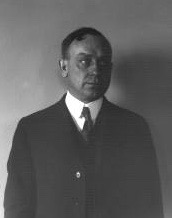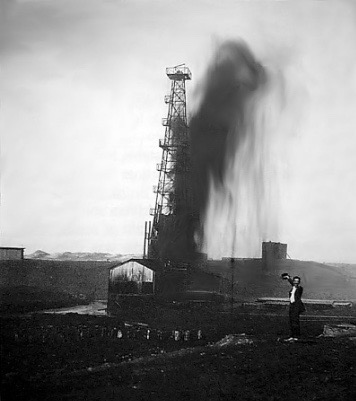Breadcrumb
- Home
- About
- Iowa Geode Stars
- A.C. Trowbridge
A.C. Trowbridge (1886-1971)

Arthur Carlton Trowbridge was born in Glasgow, MO, on March 4, 1886. He attended the University of Chicago, getting his BS in 1907, and his PhD in 1911; his dissertation was on the geology of the Owens Valley, CA.
Trowbridge was recruited for the University of Iowa geology faculty by George F. Kay; reportedly there was considerable competition for his talents. He joined the faculty in July, 1911; the following month he married Sue Estelle Bussey. They eventually had two children, Charles Lambert and Carolyn Frances.
Trowbridge taught general geology, and was responsible for introducing summer field courses and laboratory methods to the curriculum. He was described as a protégé of Rollin Salisbury, and in 1911 and 1912 they published three manuals on the interpretation of topographic maps. During World War I, he was on leave from the university, serving as an education director at the US Army YMCA at Camp dodge, then in New York City. In addition to his teaching duties, Trowbridge was involved in various government field projects. These included geological mapping of the Galena (IL) – Elizabeth (IA) quadrangle with E. W. Shaw for a USGS folio atlas; working on the geology of the lower Rio Grande valley in Texas (which led to important contacts with the oil industry); and working with the U. S. Engineer Corps (forerunner of the Army Corps of Engineers) on sediment deposition in the Mississippi delta.
Trowbridge’s areas of research were physiography and glacial geology, later also including stratigraphy and sedimentation. He wrote many research papers on the “driftless area” of the Upper Mississippi Valley.
In 1925, Trowbridge coned the term “sedimentology,” and referred to himself as a sedimentologist, although the term was not published until Waddell did so in 1933 (acknowledging its origin).

The most unusual event in Trowbridge’s career needs some backstory. After World War I, it became apparent that the future was going to require enormous amounts of oil. Russia, one of the major sources, became out of bounds because
of the revolution. Other sources were questionable because they were colonial holdings, and the potential sources in the Middle East had just passed from Turkish to French and British control. In the United States, there was an awareness among American oil companies that domestic sources might be inadequate, and they needed to explore overseas. In many cases, they were met with resistance from the British, French and Dutch oil companies, reinforced by their governments. This led to the Americans demanding an “open door” for exploration. Initially, this didn’t go far, but the American government began making noises about reciprocity. Many of the European companies had substantial business holdings in the United States (Shell produced 50% more oil than Standard Oil), and the political pressure caused the Europeans to back down.
An immediate result was in the makeup of the initial oil explorations in Iraq. Turkish Petroleum Company was made up of interests from France, Shell, and Anglo-Persian Oil Company. To this was added a party of Americans from an assortment of American oil companies. Because it was done hastily, they were consultants rather than regular company geologists.
The survey kicked off in 1925 with a one-year program. There were 18 geologists, plus immense numbers of support (including local soldiers for protection). The leader was Hugo de Boeckh, a Hungarian geological advisor for the Anglo-Persian Oil Company. Because they were the largest party, he decided that he needed to be in charge of the entire operation. He proved to be a status conscious autocrat, particularly in his geological views. He believed in the “lagoonal theory,” that oil would be found in the porous lagoonal facies of limestones, and anything else was a waste of time.
The American contingent was led by E. W. Shaw, who had worked with Trowbridge a decade before. Trowbridge was on sabbatical from the University of Iowa, and was brought in to help with the field geology, particularly since he had some familiarity with oil exploration from his Texas work.
This proved to be crucial to the entire enterprise. De Boeckh wanted to find a title for himself, and “doctor” wouldn’t do (there was a newly-minted PhD with the Shell contingent). He settled on “professor,” since the only other professor in the group was Trowbridge. It some got to the point where the leaders of the American and British geologists would not talk to de Boeckh, but they could use Trowbridge as a go-between.

In a March 11, 1966, letter to Wallace Pratt, Trowbridge remembered: “My only connection with the Turkish Petroleum Company was during the preliminary survey in 1925-1926. Personally, de Boeckh and I were good friends but we had many lively discussions and some differences of opinion. Shaw and de Boeckh, on the other hand, did not get along well and before the end of the year were not directly exchanging scientific ideas or conclusions.” (Owen, 1975, p. 1299)
Added to the mix was that many of the British geologists were young and green, unfamiliar with field methods. Trowbridge wound up helping with that, and was made supervisor of all the field parties.
In the summer of 1926, the geological surveys completed their work and passed along their drilling recommendations. The leaders of the British and American parties strongly favored drilling the enormous Kirkuk structure; de Boeckh thought it was a waste of time. The compromise was that it was 8th in a seriatim of 10 wells. The actual well site, at a place called Baba Gurgur, was based on one of Trowbridge’s cross sections. He recognized that the structure involved thrust faulting; previous thought was that it was a simple anticline.
The well was drilled after Trowbridge had departed to return to Iowa, but was the discovery well on what would be considered to be the world’s largest oil field until the discovery of Ghawar. (Kirkuk is about 100 km long, with variable reservoir quality. The OOIP is estimated to have been about 38 billion bbo; the EUR is 22.5 billion bbo, almost all in the main Asmari reservoir.)
Trowbridge returned to his teaching duties at Iowa, but also to his outside consulting. During 1928 to 1930, he made geographical surveys to help with the locations for locks and dams on the Mississippi River, and in the early 1930s he consulted with various oil companies on exploration.
In 1934 he was named department chairman, as well as head of the state geological survey and state geologist. During World War II, he and A. K. Miller taught geology while the other geology professors were in the military. In 1947, Trowbridge resigned from the state geological survey to devote his time to teaching and administration.
Trowbridge retired from the university in June, 1952; from then until 1955 he worked as a consultant for Gulf Research and Development in Houston. Upon returning to Iowa, he continued teaching part time until 1965.
In 1960, Trowbridge received the Neil A. Minor award from the National Association of Geology Teachers, and in 1963 was given an honorary doctor of humane letters by Augustana College.
Arthur C. Trowbridge passed in 1971.
In His Own Words
- Trowbridge, A. C., 1911, The terrestrial deposits of Owens Valley, California: Jour. Geology, v. 19, p. 706-747. (published version of dissertation)
- Salisbury, R. D., and Trowbridge, A. C., 1912, The interpretation of topographic maps: a laboratory manual for the use in connection with the topographic maps of the United States Geological Survey. To accompany beginning courses in physiography: H. Holt and Co., New York.
- Shaw, E. W., and Trowbridge, A. C., 1916, Galena-Elizabeth Folio, Illinois-Iowa: Geologic Atlas of the United States, U.S. Geological Survey.
- Trowbridge, A. C., and Mortimore, M. E., 1925, Correlation of oil sands by sedimentary analysis: Economic Geology, v. 20, p. 409-423.
- Trowbridge, A. C., 1930, Building of Mississippi delta: AAPG Bull., v. 14, p. 867- 901.
- Trowbridge, A. C., 1932, Tertiary and Quaternary geology of the Lower Rio Grande region: U. S. Geol. Survey, Bull., Report: BO837, 260 p.
- Trowbridge, A. C., and Shepard, F. P., 1932, Sedimentation in Massachusetts Bay: Jour. Sed. Petrology, v. 2, p. 3-37.
- Trowbridge, A. C., 1966, Glacial drift in the “Driftless Area” of northeast Iowa: Iowa Geol. Survey, Rpt. Inv. 2, 28 p.
References
- Owen, E. W., 1975, Trek of the oil finders: a history of exploration for petroleum: AAPG Mem. 6, 1647 p.
- Arthur C. Trowbridge Papers 1873-1970
- UI Collection Guides collguides.lib.uiowa.edu/?RG99.0089